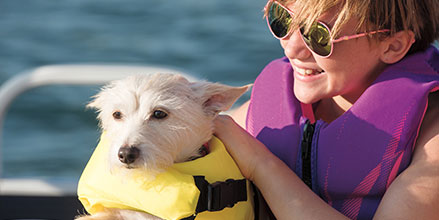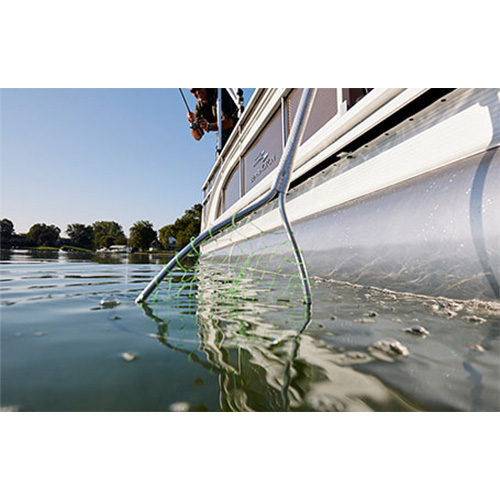
Choosing a PFD for Your Pontoon Boat Dog
If you bring your dog boating, he or she should have a good personal flotation device (PFD) and should wear it when the boat is under way.
Wait! Aren’t dogs natural swimmers?
Well, yes, most of them are, but not all. And even the strongest swimmers can get into trouble if they tire or are injured when falling into the water.
Here are some tips, many of them borrowed from REI and WikiHow, about how to pick the right canine life jacket and how to get Fido/Fidette used to wearing it.
Picking a Doggy PFD
The life jacket must fit properly and be comfortable. You don’t like to wear an uncomfortable PFD, and neither does your pooch.
Take your dog with you to the store when you shop for the life jacket. It’s a lot easier to get the right fit that way, and it avoids keeping one that doesn’t fit because it’s too much of a hassle to return.
Like PFDs for people, dog life jackets are rated by size and weight. Getting too little flotation is obviously a problem because it won’t adequately hold the dog up in the water. But too much isn’t good either, because the dog will float too high and won’t take a stable, legs-down position for effective swimming.
When you put the life jacket on your dog, it should be snug enough so that it doesn’t shift, but of course not so tight that it restricts the dog’s motion. There should be straps around the dog’s torso and in front of his/her chest to keep it secure in the water and prevent the dog from wriggling out of it intentionally. It should fit well, in contact with the dog’s body all the way around. If there are gaps or puckers it may interfere with the dog’s swimming.
There should be a handle on top of the PFD – over the dog’s back. If the suit has been properly designed, the handle will be placed at a proper balance point, making it much easier to lift the dog from the water onto the boat.
Unless you take your dog duck hunting, choose a brightly-colored PFD that can be seen easily. Retro-reflective tape or piping will greatly aid in visibility at night. Camo patterns may be more suitable for hunting dogs, but they may make search-and-rescue more difficult should the dog get into trouble.
With the life jacket on, the straps shouldn’t hang down excessively so that they can get caught on objects around the boat or interfere with swimming or running. If the ends can’t be secured, you might need to cut the straps short and heat-seal the ends with a hot knife.
Get Your Dog Used to Wearing a PFD
If new experiences frighten your dog, and he or she isn’t an experienced swimmer, plan to get him or her used to the PFD gradually and well in advance.
Start by putting the life jacket on your dog on dry land. Let the dog run around and just have a normal day with it on. After the PFD itself is no longer an issue, bring the dog to the lake and urge him or her to walk into the water on his/her own initiative. Do not throw the dog into the water.
Play with your dog in the shallows where standing is easy before moving gradually into deeper water where swimming is necessary. Take it slow and build confidence. Eventually, you can start playing fetch by throwing a stick into the water so that the dog has to swim to retrieve it.
As a final step before you go pontoon boating, you can play fetch off a dock, where the dog has to jump into the water. Once the dog is comfortable with that, jumping off the boat will feel comfortable too, and a fall off the boat, should it occur, won’t be traumatic.
Have a dog and need a boat to go with him or her? Find a Bennington pontoon boat dealer near you.












